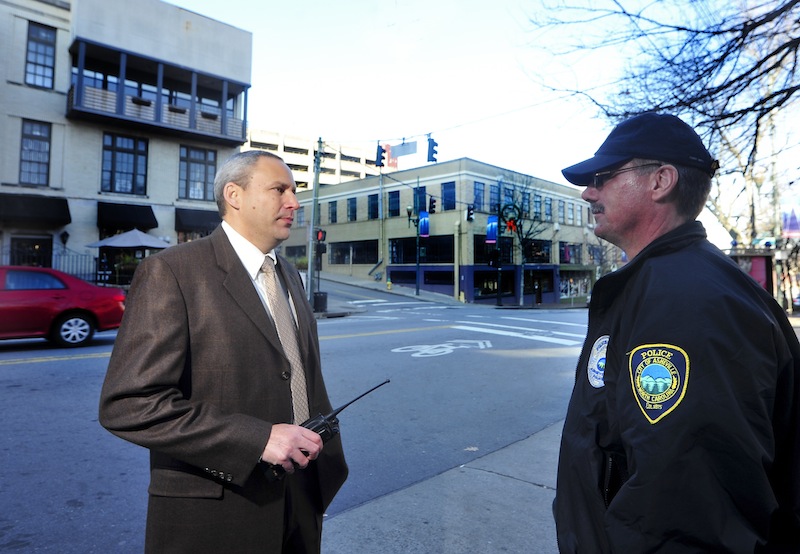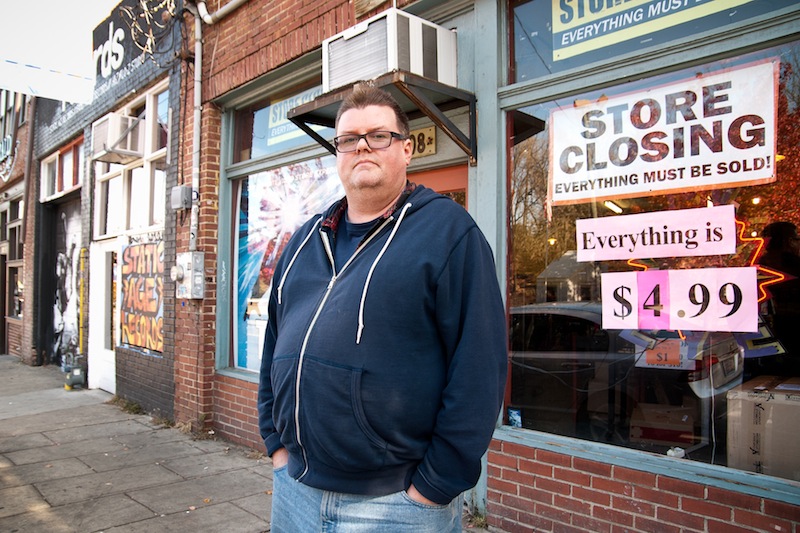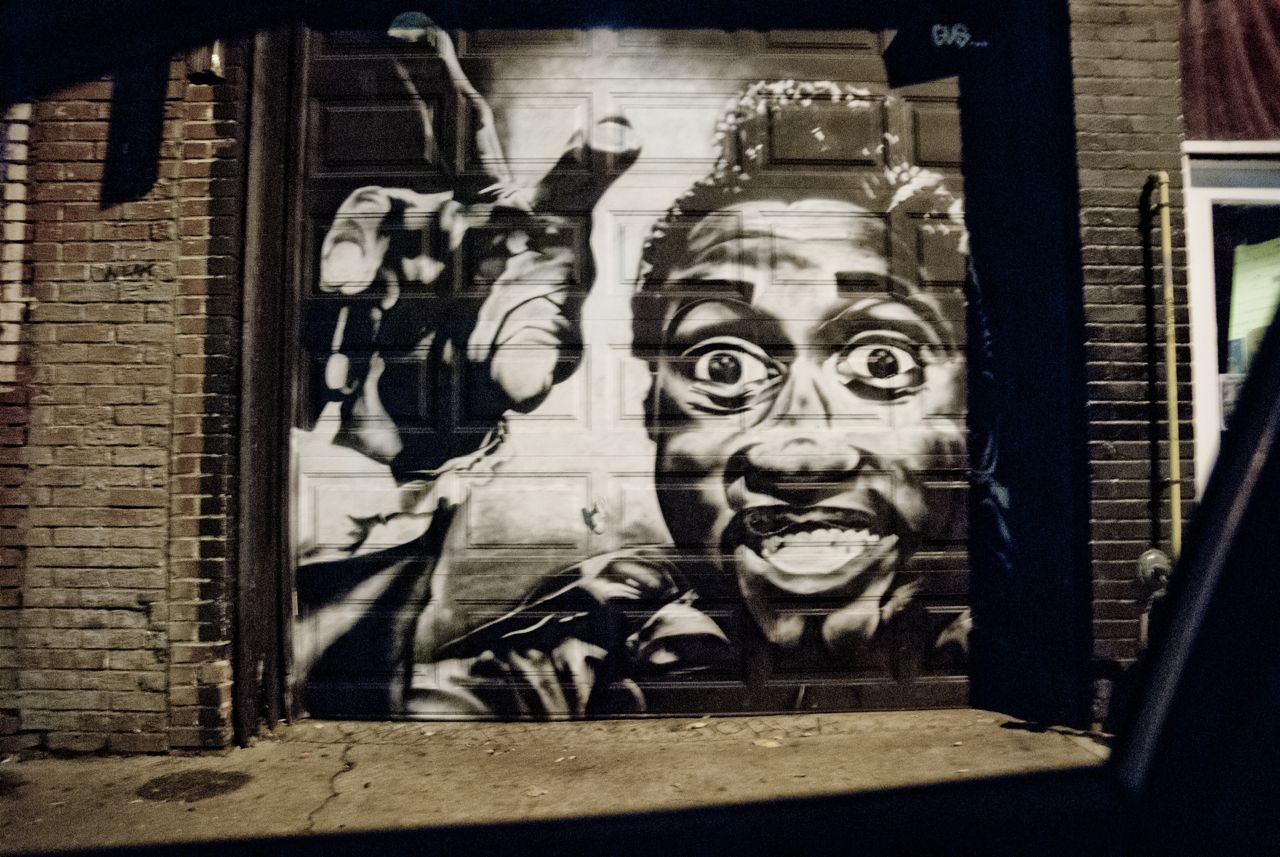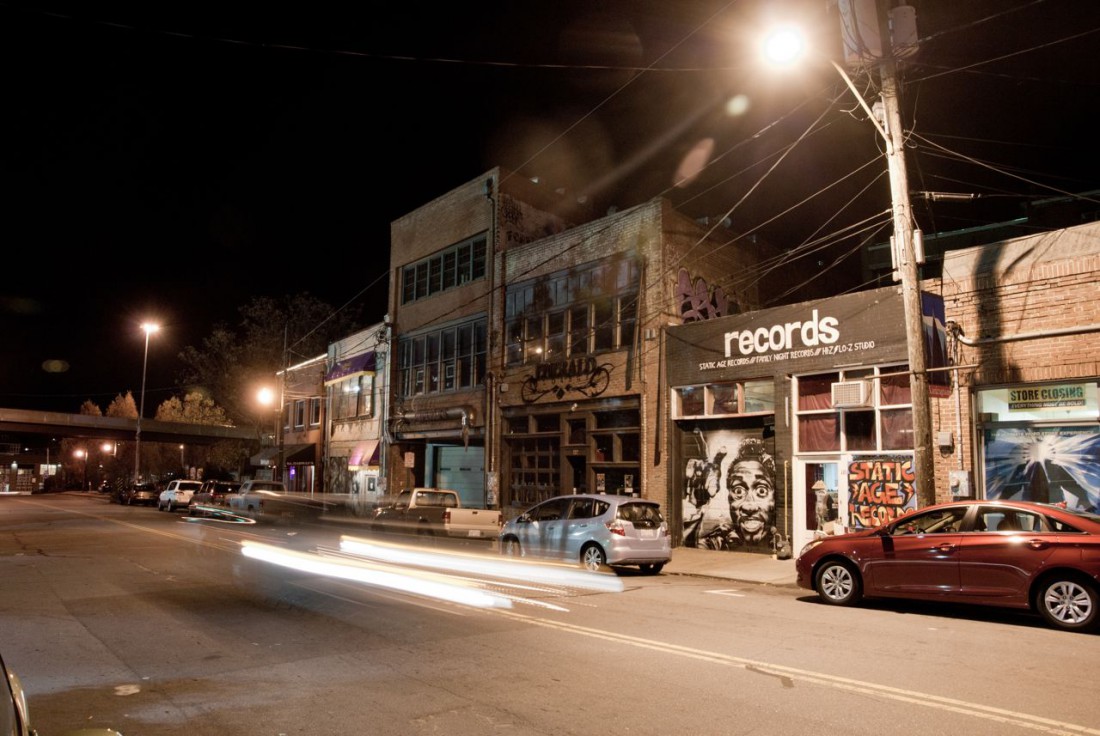Walking down Lexington Avenue toward the Interstate 240 overpass, one may hear music and snatches of conversation about things like natural foods and mysticism. Coffee and cooking aromas drift over a street where tourists, artists, merchants and the homeless all rub shoulders.
This is the heart of a downtown district known for its independent spirit, quirky local businesses and an annual street festival celebrating the city's diverse alternative cultures. Earlier this year, the American Planning Association’s North Carolina chapter hailed Lexington Avenue as one of the best main streets in the state, and a sign erected to help tourists find their way calls it a place where the "traditional meets the avant-garde."
Nonetheless, the district is no stranger to controversy, often stemming from the friction between disparate constituencies. Key players, including some longtime business owners, say violence is on the increase. And partly in response to those concerns, the Asheville Police Department has launched a new strategy for patrolling Lexington’s brick sidewalks and the rest of downtown, bringing in additional officers assigned to small, specific beats.
“Recognizing the changing dynamic downtown, we want to have our officers become much more engaged in community policing and problem solving," Capt. Tim Splain explains. “We don't always have to write a ticket or make an arrest; sometimes there's other alternatives.” The 22-year APD veteran is the department’s patrol commander.

Image 2. A new approach: Capt. Tim Splain, seen here with Officer Robert Frost, hopes the APD’s new community-policing strategy will improve the district, which he calls “a microcosm” of downtown’s success. Photo by Bill Rhodes
Overall crime rates in the area, he notes, have remained relatively stable. But those crimes have become more violent, perhaps due in part to an influx of younger transients using harder drugs. For the most part, says Splain, that violence takes the form of fights among themselves, not attacks on bystanders. He hopes the new patrol strategy will nip problems in the bud, countering the perception that Lexington (and, by extension, all of downtown) isn’t safe.
Meanwhile, paradoxically, rising rents are putting pressure on the district’s traditional businesses and residents alike, and some fear that the one-two punch of gentrification and security issues could sound a death knell for this unique haven.
More violence
The combination of intoxicated bar-goers, a shifting transient population and harder drugs has led to more violent fights, fueling the perception that the street isn’t safe.
“We come in in the morning, we see blood on the sidewalk,” says Marc McCloud, who co-owns TV Eye Video Emporium downtown and Orbit DVD in West Asheville. TV Eye, a Lexington Avenue fixture, is selling off its merchandise and will close before year’s end. Saying he “sees what's on the horizon,” McCloud believes the changing neighborhood makes the business unsustainable.
 Image 1. Blood on the sidewalk: TV Eye co-owner Marc McCloud says rising rents and increased violence on Lexington are driving out local businesses like his. Photo by Max Cooper
Image 1. Blood on the sidewalk: TV Eye co-owner Marc McCloud says rising rents and increased violence on Lexington are driving out local businesses like his. Photo by Max Cooper
“The old homeless guys are fine; five years ago you knew everyone's names. Now people are just down there getting f—ked up. There's been fights in the street the past couple of years.”
And while changing technology has unquestionably affected the movie-rental business, he says Orbit is having its best year ever. Safety issues on Lexington, McCloud maintains, are a key culprit.
“Our biggest hour used to be between 10 and 11 at night,” he explains. “People would get off work at a restaurant, clean up, come by and get some movies. We've seen the numbers of customers dwindle. Five years ago, people felt safe.”
Rosetta Star, who founded Rosetta's Kitchen, says most homeless and transient folks on Lexington aren't dangerous. She blames the problems on harder drugs, including the legal synthetics available in local shops.
“In the last year, I saw more people that were dangerously, aggressively freaked out than I've ever seen,” notes Star, adding that things have improved somewhat recently.
Splain, too, says the APD has been seeing "more violence: We've responded to more fights with guns or knives or violent incidents than we have in the past.” People who a few years ago might have gotten into a fistfight are now pulling knives and guns.
This may reflect a change in the makeup of the local homeless population. Due to the economic turmoil of recent years, “You're seeing more families, and a lot more young people than ever before,” says Heather Dillashaw, who coordinates the Asheville-Buncombe Homeless Initiative.
Splain also cites the legal synthetic substances available in some shops in the district, which he says can result in "severe hallucinogenic episodes — people passing out or falling out in the street. That's something that has caused our officers a significant amount of work."
If a business is repeatedly linked to such problems, the police will advise them on better management practices or urge them to stop selling a particular product.
“We try to appeal to the best interests of the community,” says Splain. If the business serves alcohol and "they're not being managed appropriately," the APD will work with state Alcohol Law Enforcement to have its licenses pulled.
"It's a delicate balance," he concedes.
Split personality
Meanwhile, longtimers say the steady rise in rents is triggering a sea change in the district.
“The lack of affordability is changing the face of Lexington,” Star asserts, adding, “I'm sad to see it losing its authenticity and roots.”
She opened Rosetta's in 2002; the popular restaurant now distributes its line of vegetarian cuisine through supermarkets across the Southeast. But Star believes the increased cost is driving out the very people who made the area what it is.
“As rents go up, there's a natural tendency to push out those who anchored and created it. I think we're in danger of homogenizing our culture. I don't think that's what built our town, and I don't think it's what most people who live here want.”
For his part, Splain takes the long view, recalling that when he started on the force back in 1990, “If you drew the short straw at roll call, then you got one of the downtown beats. There wasn't anything here; the officers didn't want to work the downtown beats.”
Now, however, "Lexington is a microcosm within downtown of small, local, dedicated business owners who have taken a street and made it a community,” he maintains. “They're a great example of how you can make a small area successful with a lot of hard work. That's exactly what we want to see."
McCloud, on the other hand, tends to side with Star. Businesses like TV Eye, he says, catered mostly to folks who lived or worked in the area, and with the demographics shifting, there aren’t enough of them left to support the store.
“It seems like downtown is being pulled in two different directions, one being a more big-money, corporate way,” notes McCloud. “Prices are rising, and a lot of local clientele are pushed out. The other direction is the increase in violence.” Until recently, he believes, Lexington had bucked the trend affecting other portions of the city’s core.
No significant change?
Further muddying the waters is the fact that local crime statistics show no significant change recently, though this may be due in part to the lack of sufficiently specific categories to reflect the shift.
In the last two-and-a-half years, for example, there have been four aggravated assaults, two break-ins (one at Rosetta's) and one vehicle theft, APD records indicate. The number of calls concerning civic disturbances, fights and intoxicated people has also remained fairly stable. But whether those assaults involved bare knuckles or blades isn’t indicated.
“What we feel and perceive is sometimes short-sighted,” Splain observes. “When we look back three or four years, the cycle is almost exactly the same, the number of incidents is almost exactly the same, even the dynamics are the same. Most of the crime isn't stranger-on-stranger: It's people who know each other. They get intoxicated, they fight and it spills out onto the street.”
He also blames the media for helping create the impression that downtown is dangerous, citing negative coverage of the area this spring.
“That's driving an impression about all of downtown,” Splain maintains. “I hear ‘Downtown is dangerous’ from friends, people from outside Asheville. All of downtown is safe — but all the usual crime-prevention tips apply.”
Splain remembers issues with prostitution and more widespread crime on Lexington years ago, but that's mostly gone now, he says, noting, “It's not so much a law-enforcement success; it's legitimate activity replacing criminal activity.”
Still, says McCloud, the kinds of problems he’s concerned about don’t necessarily result in immediate calls to the police.
Splain acknowledges this. “You have a woman walking by and she's gotten harassed for a week with catcalls. The situation reaches a boiling point, and we get a call. By that point there's a lot of frustration, because it's been going on for a while and we haven't necessarily known about it,” he explains.
McCloud says he's seen more aggressive panhandlers harass visitors, particularly women, and the police response has seemed inadequate. “If this is such an important tax base for the city, they're going to have to address this,” he asserts. “I've heard people say they're not coming back here.”
A new/old approach
Splain, who says he often spends a portion of his off-days downtown, reveals that he’s had similar concerns.
"When I walk around, and I know where the officers are supposed to be and I don't see them, then I get concerned — and the same for the chief," he reports.
But that’s precisely what the new approach is intended to address. "Officers will be intimately aware of what's happening in their area,” says Splain, which will help them maintain order in a densely populated neighborhood.
Previously, five officers were responsible for all of downtown. Now, two six-officer teams will supplement the regular patrols — and thanks to mobile computers and bicycles, those officers will be spending more of their time on the street, interacting with the community.
"It goes back to what New York or L.A. would do in early policing days: Here's my two or three blocks, and I know everyone in that area. I know what's normal and isn't in that area, and I become very much a part of the culture," says Splain, adding, “It's hard to do the right things if you're not aware of who's there and what they need.”
For her part, Star believes the APD is “moving in the right direction.”
Where can they go?
McCloud concedes that the district’s changing nature “is a complicated issue.” But he worries that in trying to make Lexington safer, the APD could overreact “and sweep the streets, getting rid of people who aren't bothering anybody.”
Splain, however, says the police are sensitive to the plight of the homeless and try to connect them with social services. Officers also try to help business owners understand the legal limits the police face in dealing with the homeless.
Still, he continues, “There's a difficult balancing act. The better we are at developing relations down there, the better we can be at not adding to the conflict, at mediating the situation. Downtown,” he adds, “is a huge, vital area. We want it to be successful.”
For Star, however, the broader concern is the impact on Asheville’s thriving arts community. “This is happening in the River Arts District, too; you're starting to see it happen in West Asheville. The question is: Where can the artistic community go?”
And even with the best intentions, she points out, the city may simply not be capable of controlling the kind of large-scale gentrification that's squeezed working artists and small businesses in similar neighborhoods nationwide.
“There's no simple answer about how to make it better,” says Star. “But we don't want to sanitize it to the point we've lost our spirit and charm, which is what's helped us through this global economic crash. I hope we don't create a culture that pushes away the locals. We're the heart of WNC, and the tone we set matters.”
McCloud, too, fears these pressures could eventually prove irresistible.
“I think Lexington was the last oasis for locals,” he says.
 (Photo by Max Cooper; mural by Gus Cutty, portraying Screamin’ Jay Hawkins; mural is part of Static Age Records’ storefront)
(Photo by Max Cooper; mural by Gus Cutty, portraying Screamin’ Jay Hawkins; mural is part of Static Age Records’ storefront)
David Forbes can be reached at 251-1333, ext. 137, or at dforbes@mountainx.com.




Of course you guys pick the picture where I’m not smiling.
Anybody who thinks city government cares about small, locally-owned businesses is on crack.